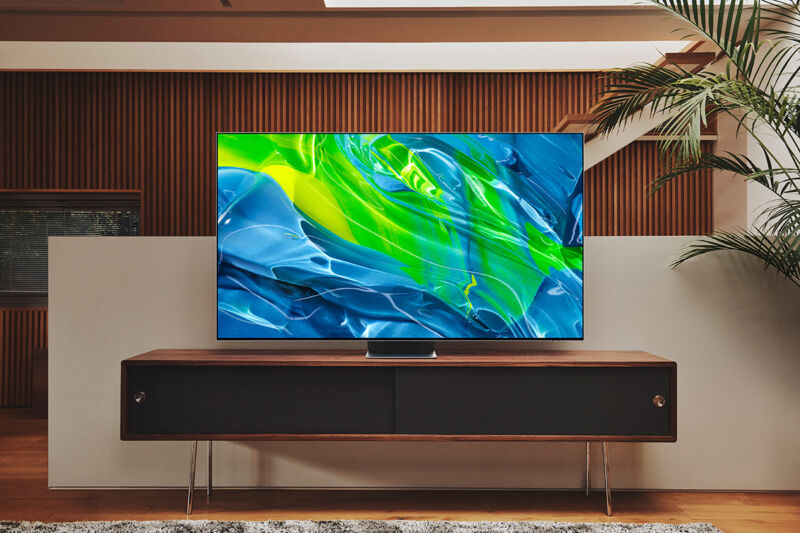

Samsung’s QD-OLED TV challenges premium OLEDs with $2,200 starting price
source link: https://arstechnica.com/gadgets/2022/03/samsungs-qd-oled-tv-challenges-premium-oleds-with-2200-starting-price/
Go to the source link to view the article. You can view the picture content, updated content and better typesetting reading experience. If the link is broken, please click the button below to view the snapshot at that time.

The Samsung OLED (S95B) —
Samsung’s QD-OLED TV challenges premium OLEDs with $2,200 starting price
Samsung's first OLED TVs in a decade priced similarly to LG's high-end G series.
Scharon Harding - 3/18/2022, 5:29 PM

Samsung revealed new details for its highly anticipated QD-OLED TV on Thursday. The company's first OLED TV in a decade costs $2,200 for the 54.6-inch model and $3,000 for the 64.5-inch model.
Samsung hadn't released an OLED TV since 2012, but in January, the company announced its reentrance into the market. Samsung is getting around LG Display's hold on OLED panels by going with a proprietary OLED technology called QD-OLED. QD-OLED applies quantum dots to OLED to deliver greater color coverage that is more consistent across brightness levels, as well as more detailed highlights and improved shadows.
The Samsung OLED (S95B) series, as it's now called, costs more than many OLED TVs, putting it in line with LG's high-end G-series of (non-QD) OLED TVs. LG hasn't revealed pricing for its 2022 G2 TVs in the US, but in Europe, the 55- and 65-inchers have been announced at 2,500 euros (about $2,758) and 3,600 euros (about $3970), respectively. The LG G1 55-inch model debuted at $2,000, with the 65-inch coming in at $2,800. LG's flagship C-series, meanwhile, costs $1,250 for 55 inches.
LED generally provides more nits of brightness than OLED. QD-OLED doesn't claim a brightness advantage over standard OLED, and the S95B's specs sheet doesn't include a brightness spec. However, the TVs have a "brightness booster feature," Samsung's announcement said. LG's upcoming G2 TVs also have a brightness booster, which works alongside a heatsink to help the TVs maintain max brightness. The TVs' LG OLED "Evo" panels should also be brighter than your average OLED, the company says.
Advertisement
Looking forward, Samsung will also have to compete with OLED EX, an upcoming OLED panel type from LG Display that claims 30 percent more brightness over standard OLED screens. We're also still awaiting pricing for Sony's incorporation of Samsung's QD-OLED panel in the 55- and 65-inch A95K series.
Samsung's 4K OLED TV will be limited to 120 Hz, unlike the sets incorporating "Neo QLED" Mini LED TVs in Samsung's 2022 TV lineup, which hit 144 Hz at 4K. However, unless you're a serious PC gamer who uses a TV as a monitor, this likely won't be an issue.
Samsung also said the upcoming QD-OLED TVs have "perceptional color mapping to deliver brighter, more accurate highlights."
Like Samsung's 2022 Neo QLED 4K and 8K TVs, the S95B series uses Samsung's Neural Quantum 4K processor for upscaling and the Tizen operating system. Other specs revealed this week include AMD FreeSync Premium to fight screen tears in gaming and 60 W audio with Dolby Atmos.
Samsung also announced pricing for its refreshed Neo QLED TVs, which start at $3,500 for 8K, with 4K preorders starting in May. There's also the Frame TV, which starts at $1,000.
Ars Technica may earn compensation for sales from links on this post through affiliate programs.
Recommend
About Joyk
Aggregate valuable and interesting links.
Joyk means Joy of geeK